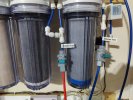Guys, I’m trying to get the standard TDS recommended values for a RODI system but I’ve a little trouble finding them elsewhere, would anyone help?
I’ve installed 4 TDS Sensors (that is 2 TDS DUAL SENSOR METER) along the system as this:
1st probe Sensor: after a prefilter, and booster pump, I know this one could be above 300 and below 500 TDS measuring quality water house.
2nd probe Sensor: after 2 pre filters, two carbon canisters, before the 2 membrane, I’m requiring this value, to determine the time that could be recommended to exchange the filters before the membrane.
3rd probe Sensor: I’ve placed this one after the two membrane and before the two DI canisters, obviously I’ve placed this one here to monitor water quality coming from membrane to determine when it could be time for a membrane swap. Intermediate value recommended need it here.
4th probe Sensor: this being the last one I know would recommend to be zero.
Any input will be appreciated. Thanks.
I’ve installed 4 TDS Sensors (that is 2 TDS DUAL SENSOR METER) along the system as this:
1st probe Sensor: after a prefilter, and booster pump, I know this one could be above 300 and below 500 TDS measuring quality water house.
2nd probe Sensor: after 2 pre filters, two carbon canisters, before the 2 membrane, I’m requiring this value, to determine the time that could be recommended to exchange the filters before the membrane.
3rd probe Sensor: I’ve placed this one after the two membrane and before the two DI canisters, obviously I’ve placed this one here to monitor water quality coming from membrane to determine when it could be time for a membrane swap. Intermediate value recommended need it here.
4th probe Sensor: this being the last one I know would recommend to be zero.
Any input will be appreciated. Thanks.

